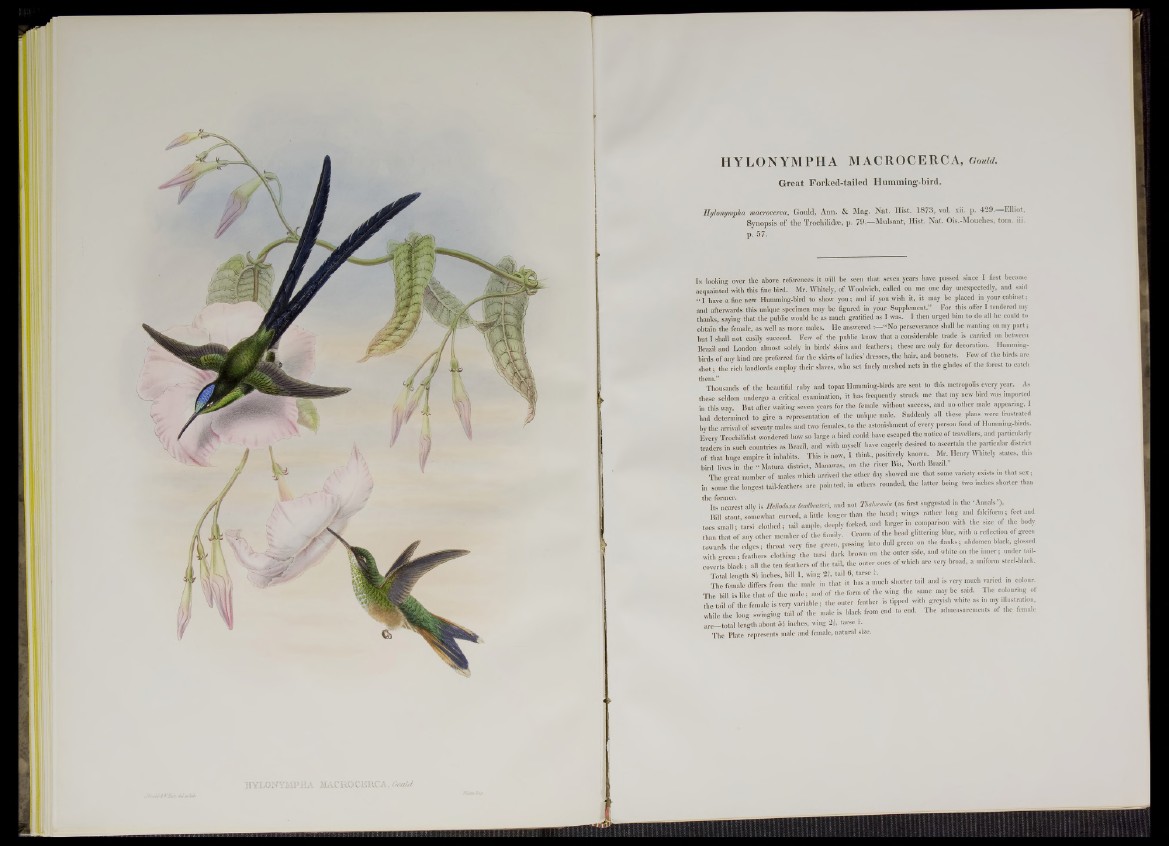
HYLONYMPHA MACR0CERCA,.6o t ^
HYLONYMPHA MACROCERC A, Gould.
Great Forked-tailed Humming-bird.
Hylonympha macrocerca, Gould, An n . & Mag. N a t. Hist. 1 8 7 3 , vol. xii. p. 4 2 9 . Elliot,
Synopsis o f th e Trochilidse, p. 7 9 .— Mulsant, H ist. Nat. Ois.-Mouches, tom. iii.
p. 57.
In looking over the above references it will be seen that seven years have passed since I first became
acquainted with this fine bird. Mr. Whitely, of Woolwich, called on me one day unexpectedly, and said
“ I have a fine new Humming-bird to show you; and if you wish it, it may be placed in your cabinet;
and afterwards this unique specimen may be figured in your Supplement/' For this offer I tendered my
thanks, saying that the public would be as much gratified as I was. I then urged him to do all he could to
obtain the female, as well as more males. He answered :—-‘'No perseverance shall be wanting on my part;
but I shall not easily succeed. Few o f the public know that a considerable trade is carried on between
Brazil and London almost solely in birds' skins and feathers; these are only for decoration. Hummingbirds
of any kind are preferred for the skirts of ladies’ dresses, the hair, and bonnets. Few of the birds are
shot; the rich landlords employ their slaves, who set finely meshed nets in the glades of the forest to catch
them.”
I Thousands of the beautiful ruby and topaz Humming-birds are sent to this metropolis every year. As
. these seldom undergo a critical examination, it has frequently struck me that my new bird was imported
in this way. But after waiting seven years for the female without success, and no other male appearing, I
had determined to give a representation o f the unique male. Suddenly all these plans were frustrated
by the arrival of seventy males and two females, to the astonishment of every person fond of Humming-birds.
Every Trochilidist wondered how so large a bird could have escaped the notice o f travellers, and particularly
traders in snch countries as Brazil, and with myself have eagerly desired to ascertain the particular district
I of that huge empire it inhabits. This is now, I think, positively known. Mr. Henry Whitely states, tins
bird lives in the IMatura district, Manawas, on the river Bia, North Brazil.”
The t numl)er of maies which arrived the other day showed me that some variety exists in that sex;
in some the longest tail-feathers are pointed, in others rounded, the latter being two inches shorter than
I the former. S I , . , t
Its nearest ally is Heliodom leadbeateri, and not Thahrama (as first suggested in the Annals ).
I Bill stout, somewhat curved, a little longer than the head; wings rather long and falciform; feet and
I toes gmall; tarsi clothed; tail ample, deeply forked, and larger in comparison with the size o f the body
than that of any other member o f the family. Crown o f the head glittering blue, with a reflection of green
I towards the edges; throat very fine green, passing into dull green on the flanks; abdomen black, glossed
I with green • feathers clothing the tarsi dark brown on the outer side, and white on the inner; under te.ilcoverts
black; all the ten feathers of the tail, the outer ones of which are very broad, a uniform steel-black.
Total length 81 inches, bill I, wing 2 i, tail 6, tarse 1. . . . . ,
The female differs from the male in that it has a much shorter tail and is very much varied in colour.
The bill is like that o f the male; and of the form of the wing the same may be said. The co ounng of
the tail of the female is very variable; the outer feather is tipped with greyish white as ... m, illustration,
while the long swinging tail of the male is black from end to end. The admeasurements of the female
are— total length about 5 i inches, wing 2 i, tarse 1.
The Plate represents male and female, natural size.